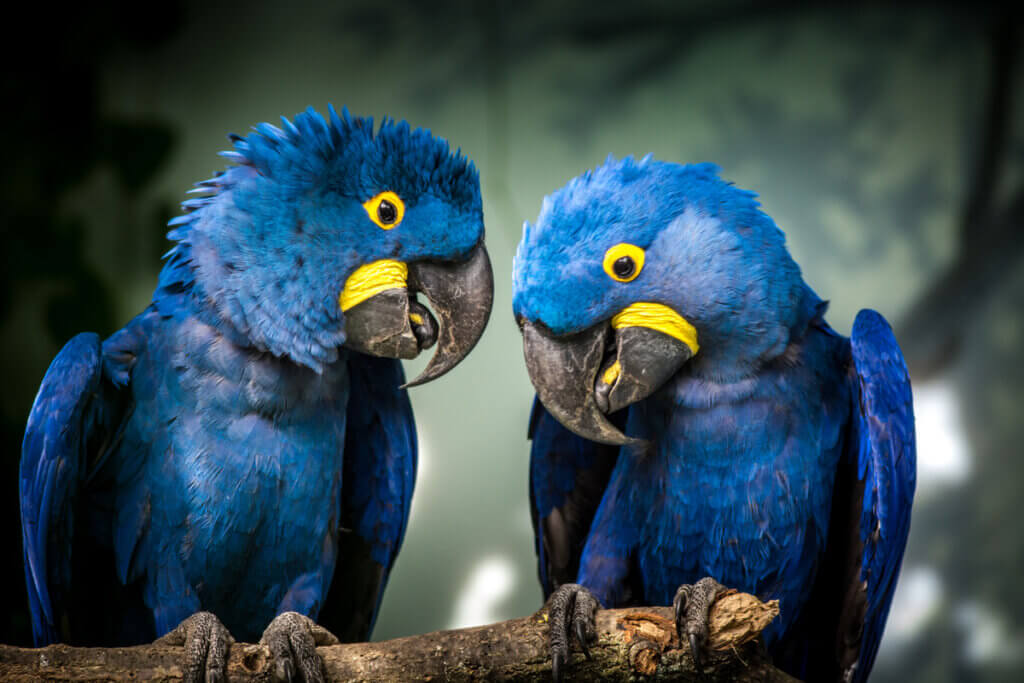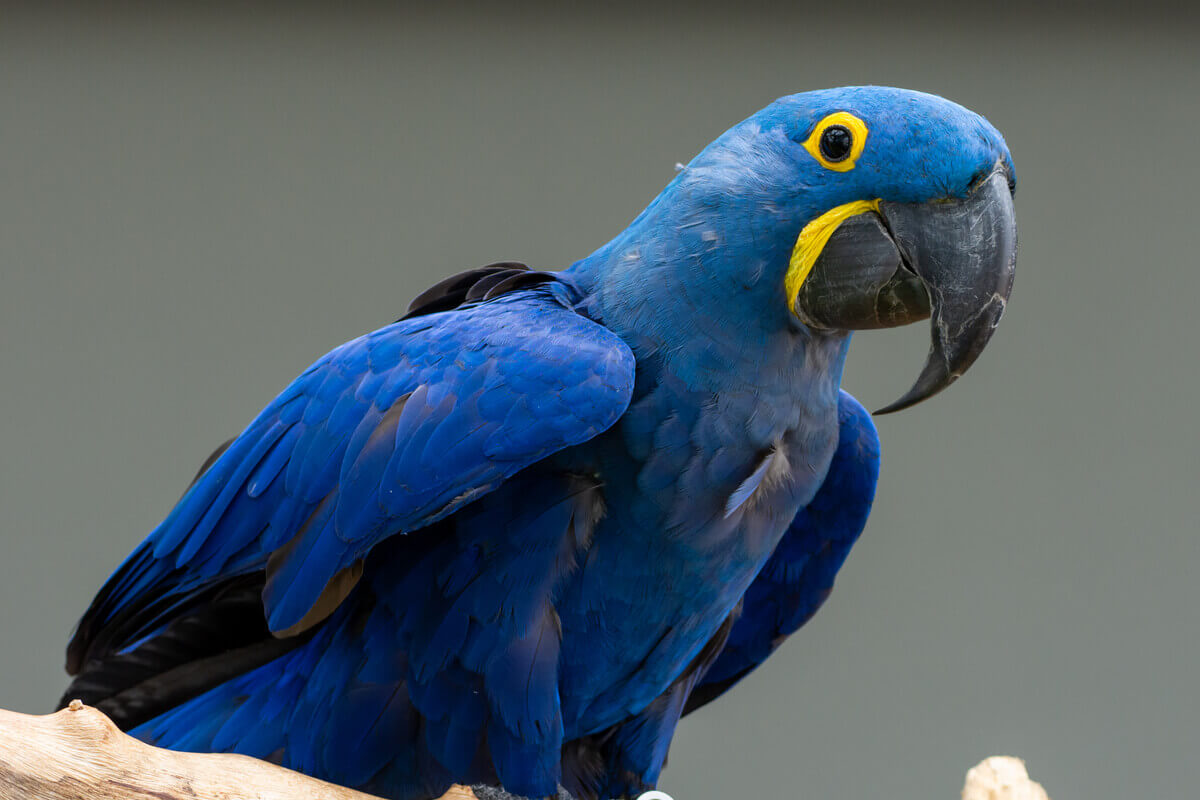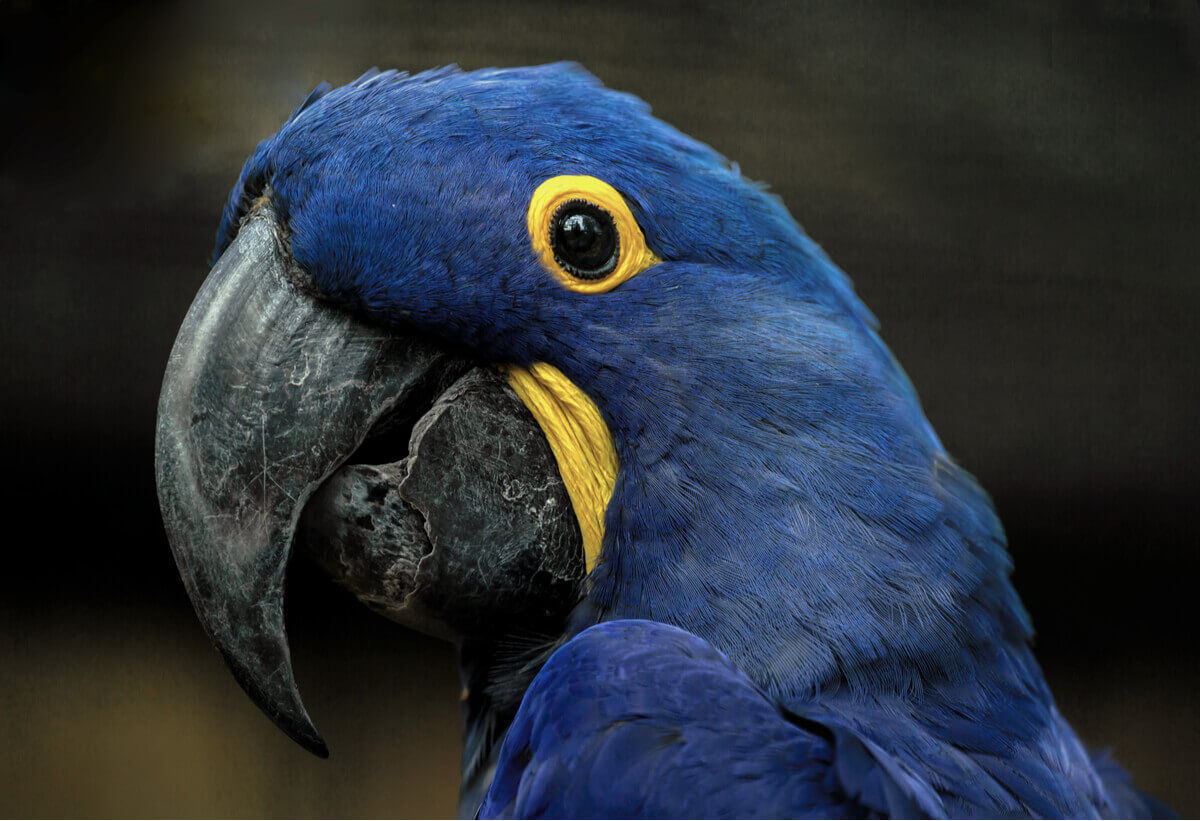8 Interesting Facts About the Hyacinth Macaw

Psittacines are the most colorful and talkative birds in the animal kingdom. Macaws are one of the largest genera and, among their most curious specimens, we find the hyacinth macaw. Today, we want to share 8 interesting facts about this beautiful bird.
Unfortunately, these birds are highly sought after on the black market and many macaws end up as victims of illegal animal trafficking. Poaching has led to the endangerment of this species, according to the International Union for Conservation of Nature (IUCN). In fact, it shares this status with many other parrot species.
The hyacinth macaw and its peculiarities
The hyacinth macaw (Anodorhynchus hyacinthinus) inhabits the jungles of Brazil, Bolivia, and northern Paraguay. It’s a large parrot, as it can weigh almost 4.5 pounds as an adult.
The hyacinth macaw is cobalt in color, an intense blue, similar to indigo, while the underside of the wings and tail are grayish. Its bill is large and strong, black in color, with a bright yellow stripe at the base. What’s more, this fascinating bird also has a ring around each eye of the same bright yellow.
Young birds have shorter tails and bare, pale yellow facial skin. Older adults have white or light gray legs. Finally, it’s worth noting that the species has no sexual dimorphism, meaning males and females look exactly alike. Here are 8 more really interesting facts about this beautiful animal.

1. The hyacinth macaw is the largest macaw
At about 40 inches long and with a wingspan of almost 55 inches, experts consider this animal to be the largest macaw of all. Each of its wings can measure up to 16.5 inches when the bird extends them, which is a considerable figure.
2. These animals live in pairs, families, or large groups.
Hyacinth macaws are highly social animals, as they form bonds and learn within the group. Psittacines are usually gregarious birds and tend to live in large groups, based on complex interactions.
3. Can hyacinth macaws use tools?
In captivity, several hyacinth macaws have displayed the ability to manipulate tools – thin wooden sticks – to open nuts and eat their contents. However, it’s not clear whether this behavior is innate or the result of social learning.
4. It’s a vulnerable species according to IUCN
The hyacinth macaw, according to the IUCN Red List, is a vulnerable species. The current number of adult specimens is 4300 and its numbers are decreasing.
The main threat to the conservation of the species is massive illegal trade. Although numbers have decreased since the 1980s – when traffickers took at least 10,000 birds from the wild – poaching still continues.
For birds living in the Amazon, habitat loss for cattle ranching and hydropower also poses a major risk. In other regions, their habitat is also in serious danger.
5. It bears a significant resemblance to the indigo macaw
The Lear’s macaw or Indigo macaw (Anodorhynchus leari) is a macaw that’s very similar to the hyacinth, although the latter is much larger. Its habitat is restricted to northern Brazil and it’s also endangered. Currently, there are an estimated 250-1000 adult individuals in the wild according to the IUCN.
6. Do these animals eat clay?
This behavior, strange as it may seem, is typical of many groups of macaws. It’s not uncommon to see these birds moving to clay deposits and pecking at the soil. Two theories have been proposed that attempt to explain this tendency:
- It’s a natural detoxifying treatment. When food is limited and safer plants are in short supply, the clay may help the birds be able to eat the more toxic plants that remain. In fact, some laboratory experiments have shown that clay may bind to toxins, keeping them out of the bloodstream.
- It provides minerals not normally found in the plant diet of parrots. In tropical rain forests, sodium, critical for nerve function and muscle contraction, is rapidly eliminated from the ecosystem, except when stored in hard clay.
Amazonian clay soils contain sodium levels 40 times higher than plant foods.
7. They nest in holes
Hyacinth macaws often nest in holes and hollow trees. Normally, they lay one or two eggs, although only one of them usually hatches. The chicks remain with their parents until they’re three months old.
8. Their favorite foods are found in palm trees
These birds feed on seeds, fruits such as mangoes, nuts, berries, flowers, buds, and leaves, although they have a preference for coconuts and dates. They choose palm grove areas for feeding and use jungles and forests for roosting or resting.

As you’ve probably realized by now, the hyacinth macaw is a fascinating animal with many impressive features. Unfortunately, illegal trade has depleted wild populations, bringing the species to the brink of extinction.
All cited sources were thoroughly reviewed by our team to ensure their quality, reliability, currency, and validity. The bibliography of this article was considered reliable and of academic or scientific accuracy.
- Borsari, A., & Ottoni, E. B. (2004). Preliminary observations of tool use in captive hyacinth macaws (Anodorhynchus hyacinthinus). Animal Cognition, 8(1), 48–52.
- Brightsmith, D. J., Hobson, E. A., & Martinez, G. (2017). Food availability and breeding season as predictors of geophagy in Amazonian parrots. Ibis, 160(1), 112–129.
- BirdLife International. 2016. Anodorhynchus hyacinthinus. The IUCN Red List of Threatened Species 2016: e.T22685516A93077457